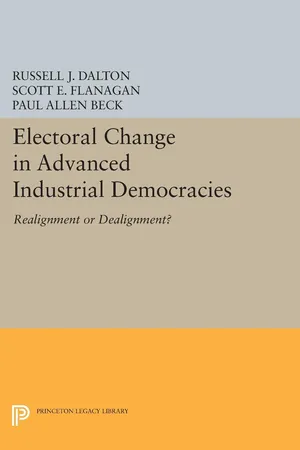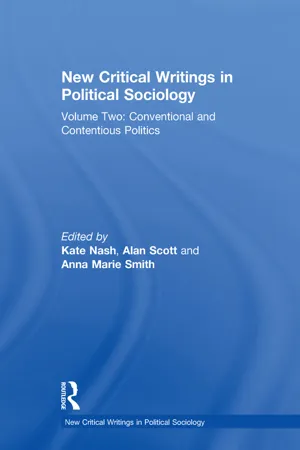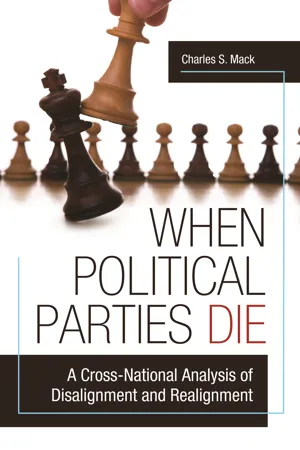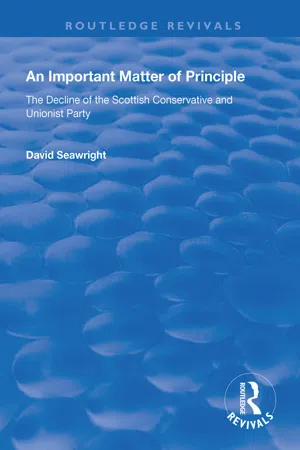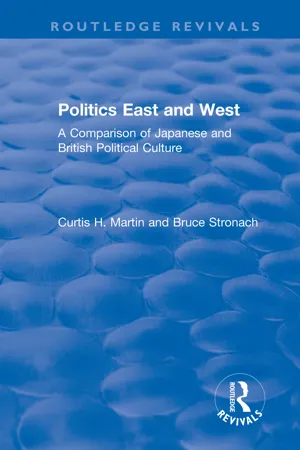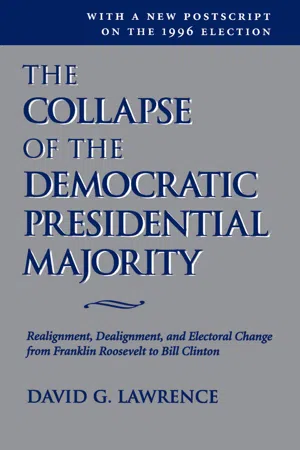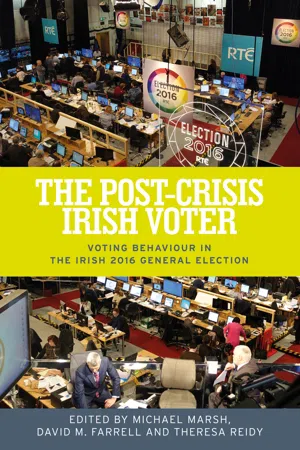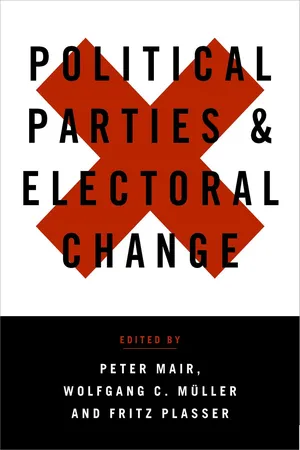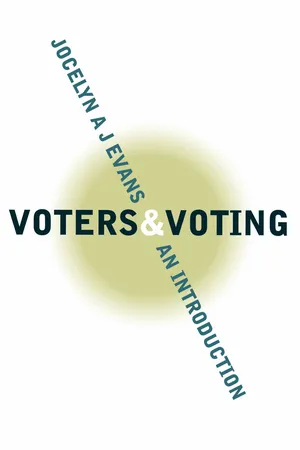Politics & International Relations
Class Dealignment
Class dealignment refers to a weakening of the traditional association between social class and political party allegiance. This phenomenon is characterized by a decline in the influence of class-based factors on voting behavior, leading to a more diverse and fragmented political landscape. As a result, individuals are less likely to vote along traditional class lines and are more inclined to support a range of different political parties.
Written by Perlego with AI-assistance
Related key terms
1 of 5
10 Key excerpts on "Class Dealignment"
- eBook - PDF
Electoral Change in Advanced Industrial Democracies
Realignment or Dealignment?
- Russell J. Dalton, Scott E. Flanagan(Authors)
- 2017(Publication Date)
- Princeton University Press(Publisher)
FOUR Patterns of Dealignment Paul Allen Beck This section presents five cases covering seven nations in which recent changes in electoral politics exhibit characteristics of dealignment. A dealignment is a decay in the preexisting mass bases of support for the political parties— that is, an erosion of the mass party coalitions. Where partisanship reflects a long-term standing decision to support a party, dealignment is identified most easily, for it will be manifested in a decrease in the party-affiliated portion of the electorate. The decay that constitutes dealignment alternatively may be hidden behind the facade of an electorate that appears to be highly partisan, if partisanship is merely an expression of momentary vote choice. Highly variable voting patterns, the rapid rise and then demise of new (flash) parties, a shift toward nonpartisan forms of political participation, and breakdowns in party support among key social groups also may signify dealignment. In one way or another, all of the nations examined in this section have experienced the kind of decay in the traditional alignments of mass politics that constitutes a dealignment. None have yet witnessed a coalescence of electoral groupings around new lines of cleavage that is widespread enough to signal a partisan realignment. There are some signs of realignment-type change in at least one of the cases, but it is not yet sufficient to bring an end to the period of dealignment. Scholars have not agreed on whether dealignment is a new type of democratic politics or merely a prealignment stage in the electoral cycle. In either event, a focus on dealignment as a distinct type is required. The most direct evidence of dealignment is found in the United States, where partisanship is a meaningful and enduring group identification for most voters. Using both trend and panel data from 1952 to 1980, Paul Allen Beck shows that the partisan share of the American electorate declined precipitously after 1964. - No longer available |Learn more
New Critical Writings in Political Sociology
Volume Two: Conventional and Contentious Politics
- Alan Scott, Kate Nash(Authors)
- 2017(Publication Date)
- Routledge(Publisher)
Part I Class Elections and PartiesPassage contains an image
[1]CLASS VOTING IN CAPITALIST DEMOCRACIES SINCE WORLD WAR II: Dealignment, Realignment, or Trendless Fluctuation?Jeff ManzaDepartment of Sociology, Pennsylvania State University, University Park, Pennsylvania 16802Michael HoutDepartment of Sociology, University of California, Berkeley, California 94720Clem BrooksDepartment of Sociology, State University of New York, Stony Brook, New York KEY WORDS: political sociology, class analysis, political behavior, political changeABSTRACTOver the last two decades, many social scientists have argued that the stable class politics of industrial capitalism is giving way to newer types of social and attitudinal cleavages. Some scholars have gone further to associate what they see as significant declines in the anchorings provided by class with the rise of new political movements, parties, and even politicians standing for office completely outside traditional party systems. Advances in class theory and statistical methods coupled with the availability of high quality data have led others to reexamine the issue. They have suggested that these arguments reflect a misreading of the empirical evidence and/or exaggerate the significance of these developments. We conclude that despite the absence of a clear consensus in the field, theories asserting a universal process of Class Dealignment are not supported.INTRODUCTION
The sociological study of politics centers on two broad concerns: the relationship among social structures, social action, and political institutions (or more generally the interaction between “states” and “societies”), and the social bases of individuals’ political behavior. The seminal postwar work in political sociology, Seymour Martin Lipset’s Political Man - eBook - PDF
When Political Parties Die
A Cross-National Analysis of Disalignment and Realignment
- Charles S. Mack(Author)
- 2010(Publication Date)
- Praeger(Publisher)
50 When Political Parties Die in the South and New England are now “virtually a mirror image” of the Roosevelt era. 38 He observed that the philosophical realignment seemed clear-cut, even though the parties were then more or less at parity, as they had been for the preceding 15 years. “[But] today’s postindustrial sociopo- litical environment makes it exceedingly difficult for any party to establish stable, long-term loyalties across much of the population.” As Ladd was expanding on this conception of philosophical realign- ment, a new theory of voting and elections had emerged that dealt with some of the same problems he and Burnham had discussed. Observing signs that voters were moving away from political participation and that party strength was weakening, Martin Wattenberg said that realignment had stopped as the party system became dealigned. Voter turnout was de- clining and the public seemed to perceive decreasing value in their lives from political parties. We will return to this subject of dealignment pres- ently, but it is important at least to introduce it at this point before launch- ing into the next discussion of works by Paulson and Stonecash. Realignment is a phenomenon of party-based voting; dealignment rep- resents processes affecting the party system: disaffection from the politi- cal process, the attenuation of party strength and affiliation, lower voter turnout, and the increased importance large numbers of voters give to choices of individual candidates rather than party preference. While some political analysts had perceived in political developments the demise of realignment, others had seen it transformed through the instrument of dealignment. Two recent books have sought to revive realignment theory as it applies to American politics. - eBook - ePub
- Peter Saunders(Author)
- 2021(Publication Date)
- Routledge(Publisher)
The first criterion is simply that absolute class voting declines. This is essentially what Sarlvik and Crewe mean by ‘Class Dealignment’. They recognize that the voting patterns of manual and non-manual workers are still very different (60 per cent of the latter supported the Conservatives in 1979, while 50 per cent of the former voted Labour), but they go on to point out that the association between class and voting has been weakening over the years. Indeed, in a later paper, Crewe (1986, p. 620) points out that, at the 1983 election, ‘For the first time since surveys began, the majority of voters declined to vote along class lines.’ Just 42 per cent of the working class voted Labour in 1983, while 55 per cent of the middle class voted Conservative (the equivalent proportions in 1945 stood at 62 per cent and 63 per cent respectively). Clearly, if Class Dealignment is defined as fewer middle-class people voting Conservative, and/or fewer working-class people voting Labour, then such a process has indeed been taking place. As Franklin puts it, ‘Is class, then, still the basis of British politics? At the individual level, the answer must be an unequivocal “no” ‘ (1985, p. 125).There is, however, a second criterion of Class Dealignment which takes issue with such reasoning. It sees dealignment as referring not to absolute but to relative class voting. This is the definition adopted by Heath, Jowell and Curtice (1985, 1986) in their analysis of the 1983 election survey, and it is endorsed by Marshall and his colleagues in their recent study of class in Britain (1988). According to this position, Class Dealignment can only be said to have occurred if cross-class voting increases. A decline in working-class support for the Labour Party, such as occurred in 1983, does not constitute evidence for Class Dealignment if Labour support also drops in other classes, for all that this indicates is that Labour is performing badly across all classes. As Heath, Jowell and Curtice explain, ‘Labour remained a class party in 1983; it was simply a less successful class party than before’ (1985, p. 29). Seen in relative terms, there has been no process of Class Dealignment in postwar Britain. Labour support has been falling, partly due to the shrinkage of its traditional manual working-class base, and partly due to its declining popularity among all classes, but the likelihood of a working-class elector voting Labour rather than Conservative - eBook - ePub
An Important Matter of Principle
The Decline of the Scottish Conservative and Unionist Party
- David Seawright(Author)
- 2018(Publication Date)
- Routledge(Publisher)
But none of these claims are backed by the analysis of any long-term trend data on religion and voting behaviour in Scotland. There is in fact an uncanny resemblance between these statements and the claims that Labour’s vote across Britain as a whole had declined because of a decline in the influence of class on voting behaviour. Labour it is argued is particularly dependent on class based appeals to garner in its support (Robertson, 1984). But those appeals have increasingly lost their resonance as the ties of social class have been eroded by, for example, increased social and geographical mobility. Meanwhile parties with non-class appeals such as the Liberal Democrats have prospered. So, it is argued, Labour has lost the support of its working class base in just the same way that it is claimed that the decline of religion in Scotland has led the Conservatives to lose their Protestant base. Even some of the reasoning as to why Class Dealignment has occurred echoes the claims made about religion in Scotland. Kendrick and McCrone in the quotation above refer to the increased influence of television and the decline of the cohesive networks found in traditional working class communities, arguments which are also put forward to explain why class has declined (Butler and Stokes, 1974; Crewe, 1984; Franklin, 1985 and Rose, 1980).The claims about Class Dealignment have been the subject of considerable controversy in recent years (Heath et al, 1987; Heath et al, 1991; Evans et al, 1991). This controversy has underlined the need to observe two important distinctions in making claims that dealignment (of any kind) has been responsible in the decline in a party’s fortunes. The first is that if we are to demonstrate that dealignment has been a cause of a party’s misfortunes we need to examine the relative level of aligned voting, not the absolute - eBook - ePub
Politics East and West: A Comparison of Japanese and British Political Culture
A Comparison of Japanese and British Political Culture
- Curtis H. Martin, Bruce Stronach(Authors)
- 2017(Publication Date)
- Routledge(Publisher)
The fortunes of British parties are seen to parallel, if not to depend on, the above changes in class composition and loyalty (Scarbrough 1987: 221). The diminution of voter identification with both Labour and Conservatives is known as partisan dealignment. Denver finds that a modest decline, from 81 percent to 70 percent, occurred in the proportion identifying with either the Labour or Conservative parties between 1964 and 1983. Others have cited a more significant decline (Norton 1984: 90). But the drop has been steepest among strong identifiers—from 40 percent to 23 percent—over the same period (Denver 1987c: 239). Alt (1984: 300) calls the decline of strong identifiers "precipitous." Heath and Topf (1987: 51) tend to stress the emergence of greater volatility, as "support for the political parties seems to fluctuate widely from month to month, and even week to week."The net result of class and party dealignment is that the old social cleavages model no longer appears as compelling as it once did (Denver 1987c: 239; Scarbrough 1987: 220). As "the stabilizing factors" of class and party have weakened, voting behavior has become more volatile (Kavanagh 1985a: 109). The exception to the pattern seems to be among nonwhite voters, who still exhibit strong party (Labour) loyalty, with 81 percent indicating that they always vote for the same party (Chariot 1985: 149). Party dealignment is seen to have seriously eroded the partisan basis for voting choice over the past thirty years. Dealignment seems to affect voters regardless of age (Clarke and Stewart 1984: 695).Recent elections suggest the extent of change within the traditional class bases of the Conservative and Labour parties. Some "new" members of the middle class—public sector, white-collar trade unionists have been defecting from the Conservatives, while more affluent, home-owning manual workers have been defecting from Labour. Conservatives have been losing votes among the British intelligentsia and public-sector employees, who in the 1980s defected to the Social Democrats and Liberals. Middle-class government workers can no longer be relied upon to vote Conservative (Alt 1984: 305). The decline of traditional working-class deference, and the loss of the traditional advantage among women voters, further contribute to a softening of the Conservative base. These losses have more than been compensated for, however, by Conservative gains among skilled workers and working-class homeowners. The "new working class" of private-sector laborers who own their own homes, cars, and telephones are more likely to vote Conservative than those who lack these characteristics (Kavanagh 1985a: 112). How permanent these "cross-class" loyalties will prove, however, still remains to be seen, even after more than 13 years of Conservative government. - eBook - ePub
The Collapse Of The Democratic Presidential Majority
Realignment, Dealignment, And Electoral Change From Franklin Roosevelt To Bill Clinton
- David G Lawrence(Author)
- 2018(Publication Date)
- Routledge(Publisher)
Dealignment theory makes less ambitious claims: it predicts only change. In a dealigned world citizens lack the party identification anchor through which even major new issues produce stability of vote choice over time. Dealignment theory is no less precise than realignment theory on what new issues will emerge, but it is far less specific on what their effects will be and how long the effects might last. An analyst informed by dealignment theory could identify the issue at the source of Republican electoral strength in the 1980s, could observe its failure to establish the party-linked base for long-term Republican dominance, and could combine the insights of dealignment theory with some sense of economic cycles to predict that an advantage based on economic management could not last. But dealignment produces far less guidance than realignment theory about how long an individual issue will dominate the electoral agenda, how it will interact with emergent new issues, and how its period of domination will come to an end.Dealignment theory makes good sense of Bill Clinton's election as president in terms of the Republicans' economic failure at a time when they held neither an advantage in ideological issue space nor a secure foundation in mass partisan loyalties. Whether Clinton's 1992 image of moderation could survive the strains of governing, i.e., whether policy activism would inevitably rekindle an image of a governing party as ideologically extreme (as it did for Johnson after 1964 and for Reagan after 1980) was of course one of the key questions that would determine the longevity of the 1992 outcomes; so was the ability of prosperity, buttressed for the Democrats by an accompanying advantage on social welfare and class, to prove a more reliable basis for long-term Democratic success as it was for the Republicans.10Clinton's task was clearly not an easy one even before his party's 1994 debacle. Unified control of government in his first two years provided him fewer benefits than it had offered other Democratic presidents in the past: sharing a nominal party affiliation with the congressional majority no longer provides a basis for the legislative triumphs or clear legislative record it allowed Franklin Roosevelt or Lyndon Johnson. Even if the Democrats had held together well enough to allow implementation of a clear legislative program against Republican opposition, the advanced state of partisan disaggregation in the electorate made the likelihood of generating mass party loyalties that could drive elections for a generation to come would have been slim. Unambiguous personal - eBook - ePub
The post-crisis Irish voter
Voting behaviour in the Irish 2016 general election
- Michael Marsh, David M. Farrell, Theresa Reidy, Michael Marsh, David M. Farrell, Theresa Reidy(Authors)
- 2018(Publication Date)
- Manchester University Press(Publisher)
A dealigned electorate, by contrast, is usually associated with disengagement, the growth of anti-establishment populism, and, above all, political instability (Green, Palmquist and Schickler, 2004 : 222; Mair, 2013 : 19). Dealignment is one potential explanation for the high levels of volatility observed in the 2011 and 2016 elections in Ireland, as argued by Marsh and McElroy (2016 : 159). Not only were these the two most volatile elections in the history of the state, they also rank among the ten most volatile elections in post-war Western Europe (Farrell and Suiter, 2016). Fianna Fáil, which had been the biggest party in every general election since 1927, lost over 70 per cent of its seats in 2011; Labour lost an even larger proportion of its seats in 2016. A number of new parties emerged during this period, and a record number of voters turned away from political parties altogether and voted instead for Independent candidates. If these are symptoms of a dealigned electorate, then electoral volatility is likely to be here to stay. Yet at other times and in other contexts, long-term declines in party identification have been reversed following a ‘critical’ election which disrupts the old political order and subsequent ‘cementing’ elections in which new political alignments become embedded (Miller and Shanks, 1996; Wattenberg, 1996 : 138). The 2011 and 2016 Irish general elections could conceivably fit this pattern. As described by Burnham (1970), critical elections ‘are closely associated with abnormal stress in the socioeconomic system (and) are marked by ideological polarizations and issue-distances between the major parties which are exceptionally large by normal standards’ - eBook - PDF
Political Parties and Electoral Change
Party Responses to Electoral Markets
- Peter Mair, Wolfgang C Müller, Fritz Plasser, Peter Mair, Wolfgang C Müller, Fritz Plasser(Authors)
- 2004(Publication Date)
- SAGE Publications Ltd(Publisher)
Usually it is sufficient for such parties to guarantee to their potential coalition partners control of a part of the electorate that may be as small as 1.5 or 2 percent. Such are in fact the margins by which many seats are won in the plurality part of the election. This can make several small parties indispensable for the electoral success of the coalition and sometimes allows them to bargain for a higher number of safe constituency candidatures than their sheer electoral appeal would grant. 8 Party responses to electoral dealignment, 1948–92 As we have seen, the term dealignment can be used to describe changes in elec-toral market conditions in Italy to a limited extent prior to 1992. What took place after that was termed with varying degrees of emphasis a major realign-ment, a fully-fledged transformation of the party system, or even a French-style transition between different republics – that is, a fundamental change in the political system and in its relationship with civil society. To be sure, this last position takes for granted fundamental changes yet to come, even if this prospect was made less likely after parliament failed to discuss, let alone approve, institutional reform proposals already drafted by a specifically appointed bicameral parliamentary committee (Vassallo 1998). 9 But the enor-mous qualitative differences between the phenomena that characterize the two periods are such that party responses have to be treated separately. For the pre-1992 period, we will consider party responses in terms of organization, target groups, policies, candidates, relations with the state and with state-regulated media, especially television. More attention will be dedicated to the system’s Party Responses to Electoral Dealignment in Italy 121 dominant parties, the DC and the PCI, and to a lesser extent, the PSI and the MSI. - eBook - ePub
Voters and Voting
An Introduction
- Jocelyn A J Evans(Author)
- 2003(Publication Date)
- SAGE Publications Ltd(Publisher)
However, the Alford index has continued to be used as evidence that class voting in society is declining (Dogan, 2001: 102). Moreover, as Hout, Brooks and Manza argue, the index can only be used on a two-class society (1993: 265). Testing class from the Lipset and Rokkan perspective might imply a simple dyad. However, given the changing and more complex social structure of post-industrial society which we consider below, to write off class because an empirical measure based upon a situation which no longer pertains indicates decline, is a very weak basis for such a conclusion.The challenges of dealignment and realignment
From the Lipset and Rokkan ‘ideal type’ of voters aligned with their socially defined parties, a number of analyses looking at the period since the 1960s have hypothesised that this alignment has gradually been eroded by a number of phenomena. Particularly in the case of class, but also in the case of other cleavages, clear links between party and vote according to traditional social structure have disappeared. Either voters have become more individual in their voting choices, due to a rise in sophistication, political knowledge and a blurring of issues at the policy-level, and hence are likely to be more selective and hence potentially more volatile at successive elections (the dealignment hypothesis) or lines of division still exist in politics, but they have evolved from the traditional cleavages.The context to socio-political change
The key to change in the post-war period in industrial democracies is the context of changes in social structure and the social context, and consequently to the changes in electoral behaviour seen from the late 1960s onwards. Firstly, societies became notably more affluent in the period between the 1950s and the 1970s – France’s trente glorieuses (thirty glorious years), the German Wirtschaftswunder
Index pages curate the most relevant extracts from our library of academic textbooks. They’ve been created using an in-house natural language model (NLM), each adding context and meaning to key research topics.
